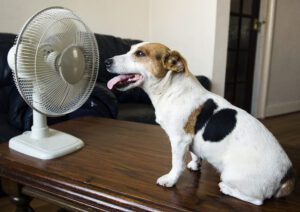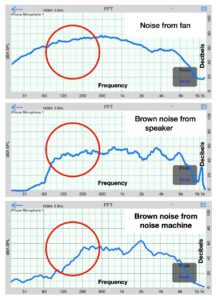It is challenging – and can be heartbreaking – to care for sound-sensitive dogs, whether they are frightened by thunder, fireworks, electronic beeps from microwave ovens or low-battery indicators, or other noises. Veterinary behaviorists can help, prescribing medications and counterconditioning and desensitization exercises to reduce the dog’s noise sensitivity or noise phobias over time. But to immediately reduce the intensity of the sounds that frighten your dog, you can employ “acoustic masking” or “sound masking,” which can decrease the potency of the sounds as triggers for anxious or phobic behaviors. Note that this technique is not the same as noise canceling, which employs a different technology to reduce surrounding sounds and is delivered via headphones or earbuds – not good options for dogs!
What is sound masking?
Acoustic masking is a technique whereby we add sound to the environment to reduce the intensity and intelligibility of unwanted sound. Adding a masking sound makes it harder to detect and discriminate between other sounds in the environment. It raises the amount of ambient noise in an environment, and can help sudden noises be perceived as less sudden. Sometimes the problem sounds become completely undetectable; more often, with thunder and fireworks, they are toned down and become less startling to the dog.
Reducing the effects of irritating or scary noises from sensitive individuals, human and canine, is an enormous industry. There are a variety of tactics that may be employed to meet this goal, but the one that has been shown to be most effective for dogs is acoustic masking, discussed at length in the main article. You may also see the terms auditory masking and sound masking, whose meanings are similar enough that the terms are sometimes used interchangeably. Don’t confuse acoustic masking with these other noise-management technologies:
Noise-canceling: Sound as we (and our dogs) hear it is caused by compression and decompression of particles in the air, resulting in ripples in the air that “press” on our eardrums in complex ways. Noise-canceling devices monitor and sample these sound waves and produce waves that are precisely inverted forms of the environmental sound waves, which “cancel” each other out. This technology is delivered via headphones or earbuds (or large-scale systems in rooms, but these are prohibitively expensive for home use). The noise-canceling devices are equipped with microphones that take in the environmental noise, a digital signal processor that analyzes that noise and determines the opposite sound waves, and speakers that produce the reversed sound waves. Such a system can cancel a considerable amount of the ambient sound for the wearer, but they do not create a silent environment. Fully tested sound canceling headphones are not yet available for use in dogs.
Note that while the phrase “noise canceling” is in common usage, the technology is more precisely called “active noise canceling” (ANC), as it uses a power source to generate its “anti noise.”
Passive noise control: Also known as noise blocking, this is the use of various materials to actually block sound waves from reaching eardrums. Earplugs are the most common form of passive noise control used by humans. There are a variety of noise-blocking wearables made for dogs, such as Mutt Muffs and Rex Specs Ear Pro, but not all dogs will cooperate with wearing them, and they do not block the low freuqencies of thunder and fireworks effectively.
Masking happens in real life all the time. And the masking sound need not be extremely high volume. Masking is happening when we find it hard to follow what a friend is saying when we are together in a crowd of people who are conversing, even if the people are not speaking loudly. But of course, some loud noises are very effective masks, as you will know if you have ever tried to talk over the sound of a vacuum or a circular saw.
Best candidates for sound masking for dogs
The following types of sounds are the gold standard – good for masking any problem sound:
- Generated random or other broadband noise. The term “random noise” refers to artificially created noise that is generated according to an algorithm. It contains an ever-changing mix of many frequencies. Brown noise has the most low frequencies and is the most versatile mask. Pink noise has a moderate number of low frequencies, and white noise has the least. But if all you have available is white noise, use it!
Recordings of the ocean, waterfalls, generators, plane travel, and winter snowstorms are usually broadband and have many of the properties of random noise. Some of these can be more pleasant for humans. Just don’t choose things like trickling streams or spring rain if you are masking storms or fireworks. Go for the massive, broadband sounds with low frequencies, after making sure they don’t scare your dog.
Note: It’s more acoustically effective to play audio recordings from YouTube or another source over a home sound system than employing a standalone noise machine. Use a high-quality speaker for good low-frequency coverage. Many noise machines lack the ability to put out the essential low frequencies.

- A fan. The bigger the better, the more powerful (higher air flow velocity) the better. But any fan helps. Even the battery-operated fan I tested put out lower frequencies than my sound system.
You have a number of effective random-noise generators that can be used for sound masking in your home, including:
- Washing machines and dishwashers. You can plan your normal usage for the thunderstorm or heaviest fireworks period so you don’t waste water.
- Clothes dryers. If your dog can tolerate it, you can put a pair of sports shoes into a dryer on “air dry” for a very effective mask for booming noises (like those in fireworks shows).
- Anything with a motor. Even robot vacuums can help if your dog isn’t afraid of them.
The gold-standard sounds listed above are versatile and powerful. But here are some other options that can work in specific situations or when you don’t have access to the best noises.
- Some kinds of music. Just remember the principles: You want the inclusion of plenty of low frequencies, near constant volume, and no long breaks between pieces. The volume issue rules out a lot of Western classical music (e.g., symphonies and operas from the Romantic period) and some jazz. Many forms of pop music are good, with heavy metal and taiko drumming creating effective sound masks. But use these types of music only if your dog is already accustomed to them and blasé about them. You may have heard about studies where heavy metal music stressed out shelter dogs (Kogan et al., 2012). You will know if your dog is OK with this type of music. Note: I don’t recommend music because of any claimed relaxing effects. The research on dogs and music is in its infancy, and recent review articles have indicated that specially altered dog music has no positive effects (Lindig et al., 2020). Our goal is to choose music that can mask other sounds. Masking is evidence-based.
- The human voice. Human voices, especially low-pitched ones, are good at masking other human voices. A recorded audiobook performed by someone with a deep voice can be a good sound mask if, for instance, you have electricians in your house and your fearful dog objects. Most dogs are habituated to voices out of speakers and don’t mistake them for actual humans, so playing an audiobook to mask the voices of people working in another room can work well. If you don’t regularly listen to audiobooks, you can use a recording from a free audiobook site. The website LibriVox is a great source for free audiobooks. I choose books in a foreign language so I don’t get distracted by the content.
- Making noise yourself. If you know that a one-off sound your dog dreads is coming, especially if they don’t know it, you can kick up a little noise yourself to mask it. For many years, I clapped my hands and marched around when I saw the mail carrier approach my house because my dog Summer, who didn’t like thunder, was also scared of the sounds of the mail carrier stomping up the steps and rattling the brass mailbox lid. My dogs were accustomed to my doing weird things, and my stomping (I started quietly, not suddenly) and clapping saved Summer from that daily trigger. I also sometimes turned on the garbage disposal briefly. Note: If you try this and your dog still hears the scary noise, then the noises you make can become predictors, and you are on your way to adding more scary sounds to your dog’s list. Watch carefully to make sure your mask is effective and that your dog doesn’t hear the trigger noise.

Which random noise source is best for your dog?
The two sound sources that mask the best are fans and noises we play out of speakers. Which is better? Each noise source has its advantages. The most important characteristic is that your dog is not scared of it. But here is a comparison.
Advantages of Fans
- Your dog is probably habituated to fans.
- Fans generate lower frequencies than most speakers (unless your system includes sub-woofers).
- Generated random noise, especially brown noise, can scare some dogs.
Advantages of Random Noise
- Your dog may be habituated to many sounds coming out of speakers.
- Generated noise is more random, which makes for good masking. Fan noise is cyclical and doesn’t cover as many frequencies.
- You have control over the volume and type of noise.
Contrary to some advice circulating in the dog training world, there is no acoustic advantage to fans related to the purported interaction of airflow with sound waves in rooms. This is a myth. Air movement inside rooms does not interfere with sound waves. Sound waves themselves reflect off surfaces and create a complex sound field within a room within milliseconds of the sound source being turned on.
If your dog is fine with various interventions, you can double and triple up. There is no reason not to have a fan, some random noise, and some music (for you!) going simultaneously.
Why these acoustic masks work: Characteristics of a good masking sound
Frequency is one of the important ways we categorize sound and can guide our approach to protecting our dogs from noises. Frequency means how many times the sound wave performs a full oscillation per second. The unit for cycles per second is known as the Hertz. Low-pitched notes have fewer oscillations per second and high-pitched notes have more. The rumble of thunder may be in the 5–220 Hertz range. Many digital beeps are around 3,000–5,000 Hertz.
Physics tells us that the optimal masking sound is in the same frequency range as the problem sound (Gelfand, 2010, p. 187). However, it’s advisable to choose something with lower frequency sounds than are present in the problem sound. That’s because masking effects spread upward in frequency. Lower frequency sounds can mask higher frequency sounds, but it doesn’t work the other way around.
There are several other characteristics of a good mask. The sound should be constant and of a constant volume. We don’t want it to drop out or get quiet right at the moment of the loudest thunderclap.
Also, we need the sound to be broadband. This means it contains many frequencies rather than just one or two. Imagine a flute playing. That’s the opposite of broadband. There is only a fundamental frequency and a few overtones. Now imagine a large fan or a waterfall. Those are broadband sounds, with a mix of many frequencies. We want this kind of whoosh or roar when possible.
The final characteristic is the most important. Your dog needs to be OK with it. This is tricky, since the ideal masking sound is in the same frequency range as the problem sound, or lower. But there are many other qualities that make sounds differ from each other. You can shop around for a sound your dog doesn’t react to. My thunder-phobic dog Summer didn’t care for the rumble of brown noise, but she was fine with the booms of taiko drumming.
Accidental sound masking
I recently had the rare experience of a loud environmental noise helping my youngest dog, Lewis, with whom I walk in my neighborhood every day. Over the almost two years Lewis has been in my family, I have learned his likes and dislikes, what he wants to investigate, and what worries him. He is bothered by moderately sudden noises, like someone starting a car or shutting a door nearby. He is magnetized by people getting out of cars and doing things in their front yards. If a car drives up (or leaves a house) he wants to wait and watch until things settle down again. But he is not worried by ongoing loud noises, such as air conditioners, lawnmowers, or leaf blowers.
Recently on a walk, we were approaching a yard where two men were using leaf blowers. The blowers were very loud, even from down the street. We were three houses away when someone came out of the house immediately in front of us, got into his pickup truck, and turned on the engine. This always worries Lewis, and I waited to help him through the moment. But although the engine starting was audible, it blended with the backdrop of constant loud equipment sounds, and wasn’t sudden. Lewis took a brief look and kept walking.
I realized accidental masking in the environment had protected him. It was a good lesson for me about the mechanisms of masking. I could definitely hear the truck start, and I’m sure he could, too. But with the blowers as a loud background, there was no contrast of quiet vs. a sudden engine noise, so his usual worry didn’t kick in.
It’s pretty rare for the universe to arrange for the right loud sound to help us. But with deliberate planning and careful observation of our dogs, we can learn to add sounds to the environment ourselves to help them through noises that frighten them.
References
Kogan, L. R., Schoenfeld-Tacher, R., & Simon, A. A. (2012). Behavioral effects of auditory stimulation on kenneled dogs. Journal of Veterinary Behavior, 7(5), 268-275.
Lindig, A. M., McGreevy, P. D., & Crean, A. J. (2020). Musical dogs: A review of the influence of auditory enrichment on canine health and behavior. Animals, 10(1), 127.
Gelfand, S. A. (2010). Gelfand SA. Hearing: An Introduction to Psychological and Physiological Acoustics. Informa Healthcare.






This explains why my Beauceron stays in the corner of our home theatre by a speaker during July 4th fireworks! I thought she just felt safer in the corner. Thanks for this enlightening article.
I can relate to this article with walking my 16 month old dog. Noise phobia and staring on walks started last summer during the 4th of July and celebratory fireworks! Thank you for the suggestions.